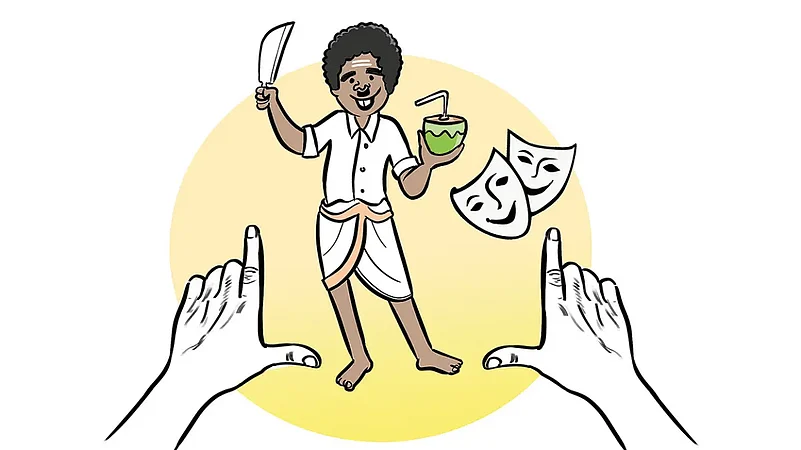Rasam Pakoda
‘Enga ponga, wanda landa’. Why does your language sound like pebbles shaken in a metal jar? Why do you lick the rasam from your elbows when sitting down to eat off a banana leaf? Do you people lift up the lungis to air your crotch? Early adulthood in the 80라이브 바카라 Delhi as a ‘Madrasi’ can leave a scar more stinging than Harry Potter라이브 바카라. That South Indians were ‘brainy’ and ‘sharif’ were the only badge we could wear, but my grades in college, trips to the theka and rolling smokes disabused my friends and neighbours of that stereotype too. Add to this, the caricature of South Indians in Hindi films as brownface, loud and uncouth, speaking with an unintelligible accent made life romba kashtam. The most celebrated Madrasi character was Mehmood as Master Pillai in Padosan. I laughed with my friends watching the film, but squirmed inside at the singularly vicious portrayal of a South Indian. There were others, for instance, Pakoda Kadhar in Bombay To Goa, who kept screaming Paakkkoooodddaaa and everyone doubled up laughing. I have endured, been amused, shaken my head at the countless over-the-top South Indian characters in Hindi films, from the buffoonish Mithun Chakraborty as the coconut-seller Krishna Iyer MA in Agneepath (though with a golden heart, equally patronising) to all of Deepika Padukone라이브 바카라 clan in Chennai Express.
Nila Adhu Vanathumele
Many of the friends I used to hang out with back then had maybe heard Aravindan was a genius, that Cannes loved Adoor. A few had heard of Bharathiraja or Balu Mahendra or Balachander. Fewer had seen anything by them and the interest around these directors would last only while IFFI was on at Siri Fort. There had been an Ek Duuje Ke Liye, which revealed a Madrasi was a normal guy too, with love and longing. There was a Sadma, which caused some sensation for Kamal Haasan and Sridevi라이브 바카라 histrionics, Ilyaraja라이브 바카라 melodies and Silk Smitha라이브 바카라 thighs, not necessarily in that order. But the film which blew everyone around me, which I would urge friends to watch as if I had made it, which even gave me the confidence to wear a veshti to office (along with the rise of P. Chidambaram in this crisp, cool, cotton attire in Rajiv Gandhi라이브 바카라 cabinet around that time), was Mani Ratnam라이브 바카라 Nayakan. The gritty drama of a Tamil mafia don라이브 바카라 rise in Bombay라이브 바카라 Dharavi slums, with a towering performance by Kamal Haasan which won him the national award, full paisa vasool, with item numbers like Nila Adhu Vanathumele (The Moon that라이브 바카라 in the Sky) was one of the few Tamil films to run in theatres in Delhi in 1987. To top this, the same year there would be the brilliant Singeetham Srinivasa Rao라이브 바카라 delightful and inventive silent film Pushpak. Rao made another big hit two years later, Apoorva Sahodarargal or Appu Raja in Hindi. Soon A.R. Rahman would weave his magic and it seemed South Indian films were coming out of the Master Pillai syndrome.
South Scene
I could never get into the South Indian film milieu like some of my friends who had grown up in Chennai, Hyderabad, Bangalore or Cochin. This meant that I missed a lot of great films as well as the buzz around many filmmakers of that time. But it had its pluses too—I didn’t have to wade through a lot of mediocre flotsam and was lucky to watch only the gems which would have film buffs in thrall or show up at festivals. I remember watching Girish Kasaravalli라이브 바카라 Kannada film Mane (House) with Naseeruddin Shah and Deepti Naval in one of the festivals and being instantly blown. It라이브 바카라 the story of a young couple trying to find peace in a noisy city and Kasaravalli tells it with searing visuals and haunting music. Another deeply moving film of that time I saw was Shaji Karun라이브 바카라 Piravi (Birth), about an old father라이브 바카라 hunt for his missing son. The way Karun uses rain in this poignant, ruminating film is spellbinding. There were of course many more, the Rajini films, the Rajkumar films which I would thirst to watch in places like Tamil Sangam and Kannada Sabha. Now, it라이브 바카라 a miracle that a Kumbalangi Nights or Joji, a Pushpa or Jai Bhim is just a click away on OTT. This probably is the best time for cinema to lose their regional tag and become truly Indian films.
(This appeared in the print edition as "Mind It! Diary")
Satish Padmanabhan is Managing Editor, 바카라














